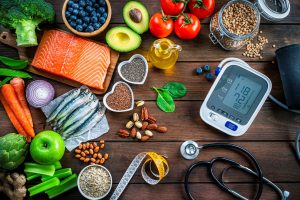 Your digestive system plays an important role in the overall wellbeing of your body. A healthy gut helps your body break down food and absorb nutrients; this affects nearly every function your body performs by providing the energy needed for those functions. Your digestive system is also the home of your gut microbiome, which is made up of bacteria that assist in digestive processes. A key part of supporting this microbiome is to consume a sufficient amount of fiber each day. Unlike other cells, your gut bacteria have the enzymes needed to break down fiber.
Your digestive system plays an important role in the overall wellbeing of your body. A healthy gut helps your body break down food and absorb nutrients; this affects nearly every function your body performs by providing the energy needed for those functions. Your digestive system is also the home of your gut microbiome, which is made up of bacteria that assist in digestive processes. A key part of supporting this microbiome is to consume a sufficient amount of fiber each day. Unlike other cells, your gut bacteria have the enzymes needed to break down fiber.
Getting the recommended amount of fiber each day (38 grams for men and 25 grams for women) can produce a variety of beneficial effects, including:
-
Healthier stools
-
Decreased constipation
-
Decreased blood sugar spikes after high-carb meals
-
Reduced appetite
There are many different foods you can incorporate into your diet to increase your intake of fiber. A few of these include:
Raspberries: A one-cup serving of raspberries contains about eight grams of total fiber. Raspberries make for a simple snack on their own, but you can also mix them in with yogurt or oatmeal.
Bananas: A medium-sized banana contains approximately three grams of fiber. Bananas make for an easy on-the-go snack, but they can also be included in sandwiches, smoothies, and other recipes.
Broccoli: This popular vegetable contains five grams of fiber for each one-cup serving. Broccoli can be cooked in a variety of ways and can be served as a side dish or mixed in with other foods, such as pasta.
Potatoes: One medium potato with skin contains about four grams of fiber. Like broccoli and other vegetables, potatoes can be cooked and served in many different ways, either on their own or as part of a more complex meal.
Brown rice: One cooked cup of brown rice contains three and a half grams of fiber.
Whole-wheat foods: Whole-wheat foods are great for boosting your fiber intake. Whole-wheat spaghetti, for example, often contains about six grams of fiber in a one-cup serving.
Almonds: Almonds, as well as other nuts such as pistachios, are snacks that serve as excellent sources of fiber, containing about three and a half grams per one-ounce serving.
If you experience symptoms of a digestive problem, you can receive treatment from a specialist at Flushing Hospital Medical Center’s Ambulatory Care Center. To schedule an appointment, please call (718) 670-5486.
All content of this newsletter is intended for general information purposes only and is not intended or implied to be a substitute for professional medical advice, diagnosis or treatment. Please consult a medical professional before adopting any of the suggestions on this page. You must never disregard professional medical advice or delay seeking medical treatment based upon any content of this newsletter. PROMPTLY CONSULT YOUR PHYSICIAN OR CALL 911 IF YOU BELIEVE YOU HAVE A MEDICAL EMERGENCY.








